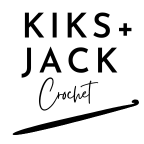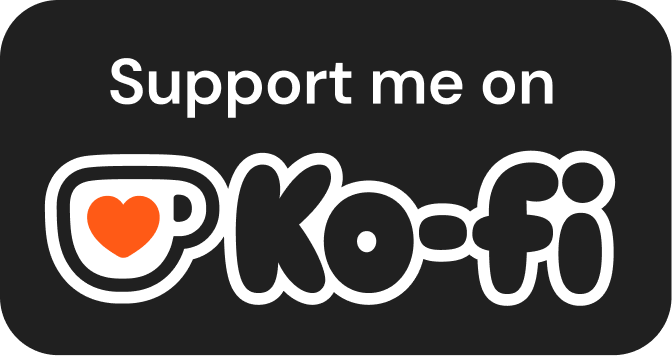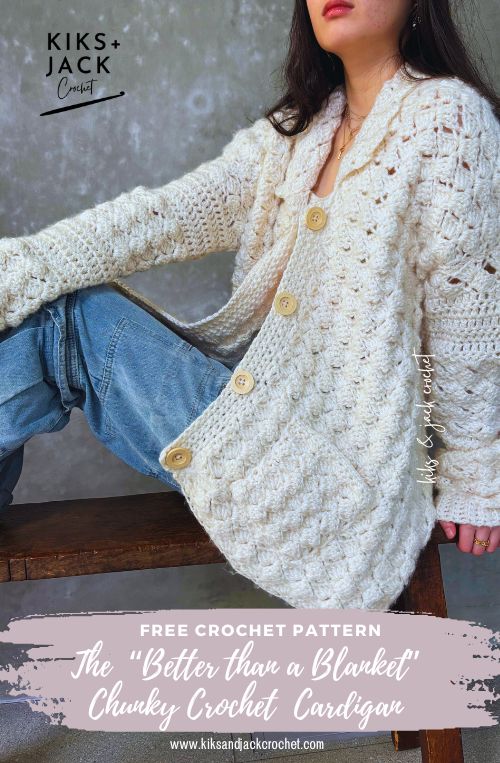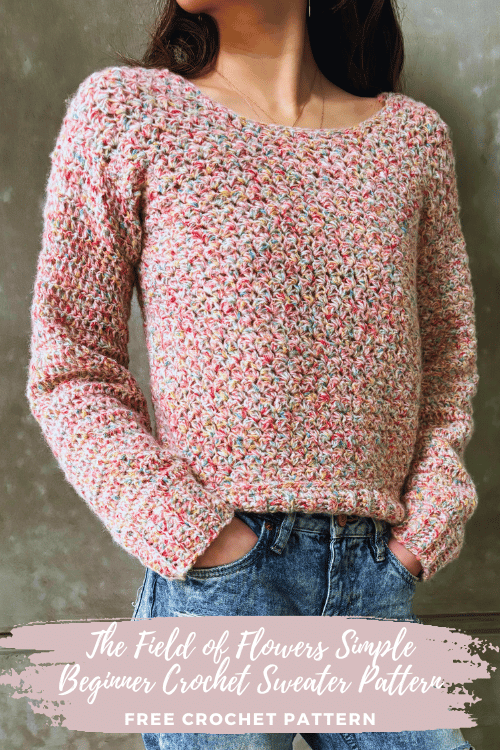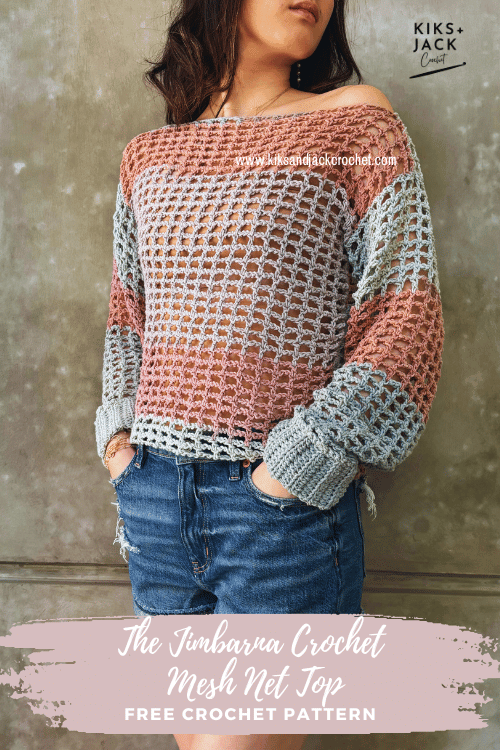Do you love the feel of soft, oversized sweaters that are easy to throw on and drape in the right places? The Lola Easy Oversized Crochet Pullover is one that you will keep reaching for. It’s simple texture, easy neckline and oversized design, makes it super comfortable to wear and cozy in the colder months.
**Update: We have finished and uploaded a video tutorial showing how to crochet this gorgeous stitch pattern. Scroll down to the “Pattern Instructions” section, and you can see we have embedded the video. It will give you a tutorial on rows 1 – 13 including the half double crochet ribbing. This video complements the full written pattern below.
The Lola Easy Oversized Crochet Pullover is a free and easy crochet pattern that is made to measure, size inclusive and beginner friendly. The full instructions are for you to view below and you can use the interactive table of contents to help you navigate this blog post.
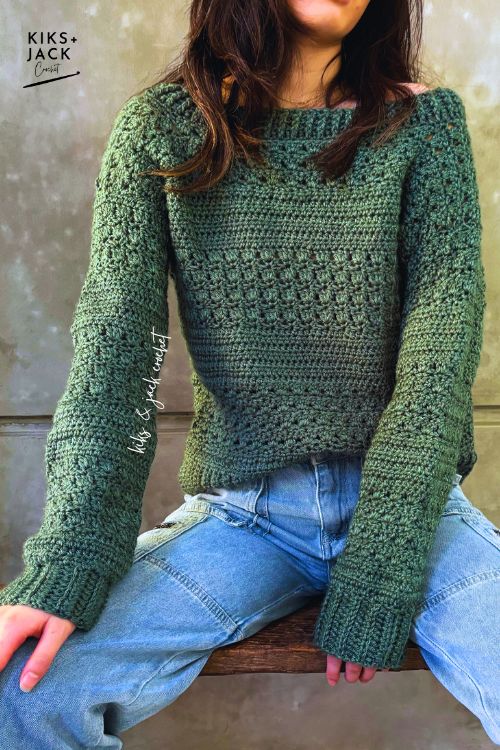
Support Our Work: We are committed to keeping all our crochet patterns free for everyone to access online. If you would like to buy us a coffee you can here at ko-fi.com/kiksandjackcrochet. Every cup of coffee fuels our creativity and keeps the free patterns coming. Thank you for keeping us inspired to design and share more free crochet patterns with you!
Initially we were going to design a tight crew neckline. However as we finished the back panel, we could see the beautiful drape starting to fall out. The looser double crochet stitch along with this specific premium acrylic yarn gave a great flow to the sweater. We changed it to a slightly wider neckline so that you could wear it off the shoulder, or on the shoulder to match the drape of the sweater. However we will show you how to customize the neckline so that it is right for you.
For our version of The Lola Easy Oversized Crochet Pullover, we used one of our favourite yarns by Lion Brand Yarns. It’s a weight 4/Medium/Worsted and this yarn comes in the most amazing colours. We love the slight sheen that gives all the colours a great vibrancy. It’s premium acrylic provides a wonderful softness and drape. Heartland is one of those beautiful yarns that you could pretty much crochet up anything, wear it out and it would look and feel amazing! You can find all the details in “Crochet Materials” below.

We definitely were looking for an oversized feel and crocheted the Lola Easy Oversized Crochet Pullover slightly longer and the sleeves oversized. If you would prefer something shorter or even cropped it’s easy to do with this made to measure pattern.
Looking for other easy oversized sweaters and cardigans? Take a look at the The Busselton V Neck Sweater for a similar slouchy feel or The Banbury Oversized Drape Crochet Cardigan for something luxurious and soft.
Let’s get started on The Lola Easy Oversized Crochet Pullover!
Stay up to date with Kiks + Jack Crochet Pattern releases and follow us on social media:
DESCRIPTION of the Lola Easy Oversized Crochet Pullover
The Lola Easy Oversized Crochet Pullover is a long sleeved pullover sweater that is created primarily from two basic stitches – the single crochet and the double crochet. The neckline can be customized to be wide or tight, and uses front and back post stitching to give it a finished look. The sweater has ribbing at the base and ribbed cuffs on the sleeves. It’s designed to hit below your hips however it can also be customized easily. The Lola Easy Oversized Crochet Pullover pattern is loose and oversized.
The Lola Easy Oversized Crochet Pullover is a free and easy crochet pattern available as a size inclusive made to measure pattern. It is beginner friendly and uses weight 4/worsted yarn however as this is a made to measure pattern the gauge is flexible.
CROCHET MEASUREMENTS & SIZES
The pattern instructions for The Lola Easy Oversized Crochet Pullover are made to measure, based on your required measurements.
Kiks + Jack Crochet will always try to write patterns that are “made to measure”. One of the best things about made to measure crochet patterns is that it celebrates the uniqueness of your body, something we all deserve from our handmade clothes. Unlike commercial sizing, which categorizes everyone into a limited range from XS to 5XL, made to measure patterns let you decide the fit based on your actual measurements. Every body is different, and we shouldn’t have to shape ourselves to fit a size chart. Let’s leave that to the big box stores as handmade should be personal. However if you would still like to use standard sizing we have listed them below for your convenience.
To use this pattern you will need the following measurements and you should write them down for easy reference:
Chest/Bust: Measure around the fullest part of your chest/bust. Do not draw the tape too tightly.
Finished length: Measure from your hips (or where you would like the sweater to end) up to the top of your shoulder at your collarbone.
Upper Arm: Measure around the widest section of the upper arm located above the elbow
Arm Length: Measure from armpit to wrist (or where you would like the sleeve to end – we typically crochet our sleeves past the wrist to the knuckles)
Wrist Circumference: Measure from one point on your wrist all around your wrist.
Standard Sizing (For Reference)
If you would like to use standard sizing for the chest/bust – then for XS (S, M , L, XL, 2XL, 3XL, 4XL, 5XL) use approximately 28-30 (32-34, 36-38, 40-42, 44-46, 48-50, 52-54, 56-58, 60-62) inches or 71-76 (81-86, 91-96, 102-107, 112-117, 122-127, 132-137, 142-147, 152-158) centimetres.
If you would like to use standard sizing for arm length – then for XS (S, M , L, XL, 2XL, 3XL, 4XL, 5XL) use approximately 16.5 (17, 17, 17.5, 17.5, 18, 18, 18.5, 18.5) inches or 42 (43, 43, 44.5, 44.5, 45.5, 45.5, 47, 47) centimetres
If you would like to use standard sizing for upper arm – then for XS (S, M , L, XL, 2XL, 3XL, 4XL, 5XL) use approximately 9.75 (10.25, 11, 12, 13.5, 15.5, 17, 18.5, 18.5) inches or 25 (26, 28, 30.5, 34.5, 39.5, 43, 47, 49.5) centimetres
Note: The Lola Easy Oversized Crochet Pullover is designed as a loose fit with significant positive ease.
CROCHET GAUGE for the Lola Easy Oversized Crochet Pullover
The Lola Easy Oversized Crochet Pullover pattern is made to measure and can accommodate for different crochet gauges. You do not need to match our swatch, however we suggest you use a hook size and yarn weight similar to ours.
For this version, we used a hook size 5 (US size 8) and a weight 4 yarn.
CROCHET MATERIALS for the Lola Easy Oversized Crochet Pullover
This section contains product affiliate links. We may receive a small commission (at no extra cost to you) if you make a purchase after clicking on one of these links.
We promise to only recommend products that we love and that we use. Thank you for supporting our small business.
Yarn brand: Heartland by Lion Brand Yarn. Weight 4/Medium/Worsted. 142g per skein and 251 yards (or 230m) per skein. Color used is Rocky Mountains.
You can also purchase Heartland by Lion Brand Yarn here on Amazon and we always check this for great deals.
Approximately 4.1 skeins or 570 grams and 1010 yards (or 923m) used for Kiks + Jacks version with a finished width of approximately 18.5 inches and a finished length of 21 inches.
5mm crochet hook (US size 8). We use many different crochet hooks and if you are looking for some great budget friendly ergonomic crochet hooks try these from Amazon. It comes in a set and the grip and the shape is amazing for beginner crocheters. We also love the slightly more pricey crochet hooks from Clover Crochet Hooks and started our collection with single hooks size 4,5 and 6.
Yarn Winder!!! (Our new LOVE). We have held off on a yarn winder for a long time. We love the idea of crochet being simple with just a hook and some yarn. However we decided to get this yarn winder, because it was affordable and we weren’t sure about investing in a super fancy one yet. We love it because it breathes life back into scrappy yarn lying around that looks messy. It’s simple to use and is holding up really well for us.
Measuring Tape. We use a super budget friendly measuring tape. Make sure it has cm and inches (not all patterns are written with both). We are always crocheting on the go so we like our tapes small and compact and we put one in our design area, one in our bag and one in our car. Retractable works best! We use these super cheap mini measuring tapes from Amazon.
Stitch Markers. We use these locking crochet stitch markers from Amazon and these stitch markers that do not lock. They are cheap and colourful.
Blocking Pins. You should buy more pins than you think you need. If you are going to take the time to block don’t skimp on the pins. We like T shaped stainless steel pins that don’t rust when they get wet. We love these blocking T pins from Amazon and the tin means the pins don’t fall out on the floor.
Yarn Needle. Buy blunt needles with large eyes for yarn. We use these Yarn Needles because we like the convenient bottle, they are budget friendly and we get lots of them!
Scissors. We love these thread snippers because they are cheap, we get two of them AND they come with a case (some don’t). Don’t carry these without the case! After you use thread snippers you won’t want to snip with scissors.
CROCHET STITCHES & ABBREVIATIONS
The Lola Easy Oversized Crochet Pullover pattern is written with US terms.
ch = chain (With one loop on your hook, yarn over and pull through the loop)
sc = single crochet (Insert hook into desired stitch. Yarn over and pull through the stitch. You now have two loops on your hook. Yarn over and pull through all two loops)
hdc = half double crochet (Yarn over and insert hook into desired stitch. Yarn over and pull through the stitch. You now have three loops on your hook. Yarn over and pull through all three loops)
dc = double crochet (Yarn over and insert hook into desired stitch. Yarn over and pull through the stitch. You now have three loops on your hook. Yarn over and pull through the first two loops. You now have two loops on your hook. Yarn over and pull through all two loops)
ch-2 sp = chain 2 space (You are crocheting into the space created by the chain 2 from the previous row and not the stitch)
BLO = back loop only
sl st = slip stitch (Insert hook into desired stitch. Yarn over and pull through the stitch. Pull through the stitch and the loop on your hook)
fpdc = front post double crochet (Yarn over and insert your hook from the front side to the back side of your work around the double crochet – the post – from the previous row, coming up on the opposite side of the stitch. Yarn over and pull up a loop. You will now have three loops on your hook. Yarn over and pull through the first two loops. You will now have have two loops on your hook. Yarn over and pull through all two loops)
bpdc = back post double crochet (Yarn over and insert your hook from the back side to the front side of your work around the double crochet – the post – from the previous row, coming up on the opposite side of the stitch. Yarn over and pull up a loop. You will now have three loops on your hook. Yarn over and pull through the first two loops. You will now have have two loops on your hook. Yarn over and pull through all two loops)
tch = turning chain
st = stitch
sk = skip stitch
* = repeat the instructions following the * as directed
Note unless stated otherwise turning chains do not count as a stitch if there are 1 or 2 chains and the turning chain does count as a stitch if there are 3 or 4 chains.
SUMMARY of CONSTRUCTION for the Lola Easy Oversized Crochet Pullover
The Lola Easy Oversized Crochet Pullover is made by first crocheting a back panel and a front panel. You will crochet the panels bottom up starting with a ribbing at the base of your sweater. This will be followed by crocheting the rest of the back panel. You will then crochet an identical front panel. After testing out the perfect neckline width, you will crochet the neckline on both panels including ribbing.
You will then crochet two separate sleeve panels starting with a ribbed cuff. Then you will seam the front panel and the back panels at the shoulder and then seam sleeves directly on to the panels. After seaming you will crochet a ribbing around the neck.
The stitch used in The Lola Easy Oversized Crochet Pullover is beginner friendly and primarily uses double crochets and single crochets.
PERMISSIONS AND COPYRIGHT for the Lola Easy Oversized Crochet Pullover
You may not publish or share any pattern on this website www.kiksandjackcrochet as your own including this pattern The Lola Easy Oversized Crochet Pullover. Except as permitted by the copyright law applicable to you, you may not reproduce or communicate any of the content on this website, including files downloadable from this website, without the permission of the copyright owner, Kiks + Jack Crochet.
You may not use any Kiks and Jack Crochet photo as your own photo.
You may crochet items to sell using The Lola Easy Oversized Crochet Pulloverpattern upon permission by email at [email protected]. Please link back to this post in exchange.
CROCHET PATTERN INSTRUCTIONS for the Lola Easy Oversized Crochet Pullover
🎥 Video tutorial — stitch only
If you would like to watch a video tutorial of the half double crochet ribbing and the full stitch pattern for Rows 1 – 13, use the embedded video below. This video only shows instructions for the stitch and should be used along with the full written pattern. Detailed row instructions are listed underneath, and you can jump to any row using the timestamps in the video.
Crochet the Back Panel Ribbing
ch 12
The height of our ribbing is approximately 2.5 inches. Based on our gauge this is 12 chains. However you can adjust the number of chains if you want to change the height of the ribbing.
Row 1: hdc in 3rd ch from hook, hdc in each ch across until end. Turn
Row 2: ch2, hdc BLO in each st across. On the last st, hdc into the whole st. Turn
Repeat row 2 until the total length of the ribbing is equal to HALF of your “Chest/Bust Measurement” + 2 inches.
K+J example: Our chest/bust measurement = 32 inches around. Half of 32 inches = 16 inches. We keep repeating row 2 until the total length of the ribbing reaches 18 inches (16 + 2 = 18 inches)
Count the total number of rows.
K+J example: We counted a total of 46 rows to achieve a length of 18 inches.
It’s a great time to check if you are completely happy with the width of the sweater before you crochet any further. We have designed this to be oversized, however you can customize this. Keep in mind that the width will increase a little further possibly up to another inch. Place the ribbing up against you to see if the width (length of ribbing) is right for you. If you would like it to be wider, crochet a few more rows. If you would like the ribbing to be tighter, then you can frog (unravel) a few rows.
Do not fasten off.
Crochet the Back Panel
You will now crochet down the long side of the ribbing that you just crocheted.
To calculate the number of stitches that you will crochet down the long side of the ribbing, calculate as follows:
| Calculation | Kiks + Jack Crochet Example |
| Count the number of rows in your ribbing | We have 46 rows in our ribbing (to achieve 18 inches) |
| Multiply this by 1.5 (round up if necessary) | 46 X 1.5 = 69 stitches |
| If this number is NOT a multiple of 3 then increase it until it is a multiple of 3 (divides into 3 evenly). If this number is already a multiple of 3, then leave it as is. | 69 is a multiple of 3 so we keep it as is. |
Row 1: Using the working yarn, ch1, sc into the first st, sc across the ribbing the number of stitches you calculated above in total. Turn
In K+J example above we will crochet 69 single crochets across the long side ribbing.
Tip: The sc may seem a little squashed. You may want to place some stitch markers across the ribbing at the 1/4, 1/2 and 3/4 marks. Then divide the number of sc stitches by 4 to give you a rough idea of how many sc you need to crochet in each quarter so you can ensure you are crocheting evenly.
Row 2: ch3, dc in 2nd st, dc across, dc in tch. Turn
Row 3-4: repeat row 2
Row 5: ch2, [1sc, ch2, 1sc] all into the 1st st, *sk next 2 st, [1sc, ch2, 1sc] in next st, rep from * across, ending with 1 hdc in top of tch. Turn.
Row 6: ch3, *3dc in next ch-2 sp (the ch2 made in the previous row), rep from * across, ending with 1dc in top of tch. Turn
Row 7: ch2, *[1sc, ch2, 1sc] all in the 2nd dc of the 3dc cluster made in the previous row, rep from * across, ending with 1hdc in top of tch. Turn
Think of row 7 as you are crocheting [1sc, ch2, 1sc] in the centre of the 3dc cluster from the previous row.
Row 8-12 (next 5 rows): repeat rows 6-7 in that order ending on a row 6
Row 13: ch1, sc in 1st st, sc across the row. Turn
Row 14: ch3, dc in 2nd st, dc across the row, dc in last st. Turn
Row 15-19 (next 5 rows): ch3, dc in 2nd st, dc across the row, dc in tch. Turn
Row 20: ch2, [1sc, ch2, 1sc] all in the 3rd dc, *sk next 2 st, [1sc, ch2, 1sc] in next st, rep from * across, ending with 1 hdc in tch. Turn
Repeat rows 6 – 20 in that order until the back panel (including ribbing) is equal to your “Finished Length Measurement” – 3 inches. The detailed instructions provided for the neckline will assume you have ended here on a row 6 so try to finish on a row 6.
Fasten off.
K+J example: Our “Finished Length Measurement” is 21 inches. Therefore we crochet rows 6-20 in that order until the total back panel including the ribbing equals 18 inches (21 – 3 = 18 inches). We finish on a row 6.
Crochet the Front Panel
Repeat all the instructions under Back Panel Ribbing and Back Panel so that you have an identical front panel.
Crochet the Neckline on the Back and and Front Panel
We will now measure out and crochet the neckline for the two panels. Crocheting two panels first without the neckline allows you “try it on” (see below) and ensure you get the perfect neckline width before you crochet the neckline on to the two panels.
Measure approximately 5-7 inches (your customization) in from the left edge of the back panel and place a stitch marker after the cluster (we will be adjusting the exact inches that is right for you shortly). This will be the start of your neck opening. Count the number of clusters from the left edge up to the stitch marker. Count the same number of clusters on the right side of the back panel and place a stitch marker.
Do the same on the front panel on both sides.
Attach the two panels together lining up the 4 stitch markers and secure the panels together with the stitch markers. Place the panels over your head and double check you are happy with the neck opening. If you would like it tighter then move the stitch markers closer to your neck ensuring you place the stitch marker at the end of a cluster not in the middle of a cluster. If you would like the neck opening wider, then move the stitch markers away from your neck. Make sure it is the same distance (ie. same number of clusters) on either side and on the front and back panel. Keep in mind that you will be adding a ribbing to the neckline that is approximately 1-1.5 inches.
Start with the back panel and attach the yarn to the first stitch near the left shoulder. (The next rows are based on the assumption you ended the panels on a 3dc cluster row).
Row 1: ch2, *[1sc, ch2, 1sc] all in the 2nd dc of the 3dc cluster, rep from * towards the stitch marker, ending with [1sc, ch2, 1sc] in the last 2nd dc closest to the st marker and then 1hdc in the next st. Turn
Row 2: ch3, *3dc in next ch-2 sp, rep from * across towards the end, ending with 1dc in top of tch. Turn
Row 3: ch2, *[1sc, ch2, 1sc] all in the 2nd dc of the 3dc cluster made in the previous row, rep from * towards the stitch marker, ending with 1hdc in the tch. Turn
Row 4: repeat row 2
NOTE: If your stitch pattern requires you to switch to the double crochet rows, then you can simply do this ie. double crochet up to the stitch marker, turn, ch3 and double crochet back across to the left side.
You can do a quick check here to see if 4 rows of neckline works for you (it will also depend on your yarn gauge). Hold it up against the top of your shoulders and if you think you need to crochet an additional row (following the same pattern) do so. Try to end on a 3dc cluster row, or a single or a double crochet row. Remember you will need to repeat this on the other side and on the front panel.
Fasten off.
Repeat Rows 1 – 4 (or more if you crocheted more) on the right side of the back panel, the left side of the front panel and the right side of the front panel.
Crochet the Sleeve Panel (Make 2)
Note we an optional adjustment to the sleeve panel pattern to provide an optional sleeve width increase. We may make some modifications from time to time to ensure our patterns can accommodate for as many different body measurements and gauges as possible.
We will now crochet the two sleeve panels starting with the cuff. Remember you will need to make two identical sleeve panels. Note that the stitch pattern changes on the sleeve.
Crochet the Sleeve Panel Ribbed Cuff
ch 12
The height of our sleeve ribbing is approximately 2.5 inches. Based on our gauge this is approximately 12 chains. However you can adjust the number of chains if you want to change the height of the ribbing or you are using a yarn with a different gauge.
Row 1: 1 hdc in 3rd ch from hook, hdc in each ch across. Turn.
Row 2: ch2, hdc BLO in each st across. On the last st, hdc into the whole st. Turn
Repeat row 2 until the ribbed cuff is equal to your “Wrist Circumference Measurement” + 2 inches. Make sure it fits comfortably and is not too tight.
Count the number of rows (we crocheted 20 rows).
Do not fasten off. Turn your ribbing. You will now crochet down the long side of the ribbing.
Crochet the Main Sleeve Panel
To calculate the number of stitches across the ribbing, calculate as follows:
| Calculation | K+J Example |
| Count the number of rows in the sleeve cuff | We counted 20 rows in our cuff |
| Double the number | 20 x 2 = 40 |
| Adjust the number upwards to ensure it is a multiple of 3 | 42 (40 is not a multiple of 3 so we adjust this to 42 so that it is a multiple of 3) |
Row 1: ch1, sc across the ribbing the total stitches calculated in the table above. Turn.
In K+J example, we would crochet 42 sc across the ribbing. It is going to be very tight, however this is normal. You may need to crochet 2sc in to the same stitch to fit in all the stitches evenly.
Row 2: ch3, dc in 2nd st, dc across, dc in tch. Turn
Row 3-4: repeat row 2
Row 5: ch2, [1sc, ch2, 1sc] all into the 1st st, *sk next 2 st, [1sc, ch2, 1sc] in next st, rep from * across, ending with 1 hdc in top of tch. Turn.
Row 6: ch3, *3dc in next ch-2 sp, rep from * across, ending with 1dc in top of tch. Turn
Row 7: ch2, *[1sc, ch2, 1sc] all in the 2nd dc of the 3dc cluster, rep from * across, ending with 1hdc in top of tch. Turn
Row 8-12: repeat rows 6-7 in that order ending on a row 6
Row 13: ch1, sc in 1st st, sc across the row. Turn
Optional Sleeve Width Increase: At this point measure the width of the sleeve panel. It needs to be as wide as the widest part of your arm which is typically your “upper arm measurement”. If you think you need to widen the sleeve panel, then in Rows 14, 15 & 16 below, increase by crocheting the dc into the 1st stitch (not the 2nd st). Crochet row 17-20 as normal and then repeat rows 8 – 13. Measure the width of your sleeve panel when you finish crocheting row 13. If you still need to expand, then repeat this increase in rows 14-16. This increase is optional and it will depend on your body measurements and your gauge. For Kiks + Jack’s version we did not need to widen the sleeve any further and followed below.
Row 14: ch3, (counts as a st), dc in 2nd st, dc across the row. Turn
Row 15-17: ch3 (counts as a st), dc in 2nd st, dc across the row, dc at top of tch. Turn
Row 18: ch2, [1sc, ch2, 1sc] all in the 3rd dc, *sk next 2 st, [1sc, ch2, 1sc] in next st, rep from * across, ending with 1hdc in top of tch. Turn
Repeat rows 6-18 in that order until the sleeve panel including the cuff, is equal to your “Arm Length Measurement“.
We will show you how to check the sleeve length again under “Assembly” so that you can ensure you have the perfect fit.
Fasten off.
Remember you need to crochet two identical sleeve panels.
Assembling the Lola Easy Oversized Crochet Pullover
Kiks + Jack Crochet highly recommends blocking all your panels for The Lola Easy Oversized Crochet Pullover before assembly. Blocking your panels will set your panels to the shape and size you want and give it a polished look.
We block our panels by pinning all the pieces on to an old yoga mat and manipulating the shape and edges so the front and back panel are similar and the two sleeve panels are similar. We then spray it with water focusing on the edges and ensuring it is well saturated. Do not remove the pins until the panels are completely bone dry.
Step 1: Seam the Front and Back Panel at the shoulder. Place the front and back panels together with the right sides facing together. With a yarn needle, seam the two panels together across the shoulders starting from the edge and across. Fasten off.
Step 2: Line up your sleeves at the midway point to the shoulder and seam. Open up the two panels (now seamed at the shoulders) so that the right side is facing the floor and the wrong side is facing upwards. Take one of your crocheted sleeves and fold it in half lengthways. Place a stitch marker at the top of your sleeve at the centre point. With the wrong side of the sleeve facing up, attach this stitch marker to the left edge of the left shoulder seam.
Customization Tip: It is a good time to check the length of your sleeve. You can “seam” it with a few locking stitch markers to the main panel. Try it on. If you would like the sleeve to be longer (eg. some like the cuff to be almost at the knuckles vs the wrist), you can remove the knot on your sleeve panel (where you fastened off) then add a few more rows on to your sleeve. Or you can reduce rows if you like your sleeves shorter by removing the knot first and pulling out (frogging) a few rows. Make sure you do the same on the second sleeve so they are identical.
When everything is perfect, using a yarn needle and matching yarn, seam the sleeves to the main panels (wrong side facing up) – see first diagram below (illustrative purposes only).
Do the same on the right side with the other sleeve.
Step 3: Seam the sides of the sweater and the bottom of the sleeve together. Fold the two panels and sleeve panels at the seamed shoulders so that your sweater is facing wrong side out. With a yarn needle and matching yarn, seam the sides of the two panels together up to the armpit and along the bottom of the sleeve. See second diagram below (illustrative purposes only).

Fasten off.
Step 4: Add the ribbing to the neckline
Turn the sweater right side out. Attach a yarn to the side of the neckline.
Round 1: ch1, sc in the first st, sc evenly around the neckline into every st. You can crochet 2sc in large spaces and 1sc in regular stitches. The key is to keep the sc even. When you complete the round, sl st to join at the top of the tch.
Round 2: ch3, dc in 2nd st, dc around into every st, when you complete the round, sl st to join at the top of the tch
Round 3: ch3, *fpdc, bpdc, rep from * until end of the round, sl st to the first fpdc. Go back up to the section Crochet Stitches & Abbreviations for instructions on how to crochet Front Post Double Crochet (fpdc) and Back Post Double Crochet (bpdc).
Round 4: repeat row 3 (or you can leave row 4 out if you want a thinner ribbing around the neck).
Fasten off.
Finish & Celebrate the Lola Easy Oversized Crochet Pullover
Weave in all your ends.
Congratulations you have finished The Lola Easy Oversized Crochet Pullover and we hope you enjoyed this free crochet pattern.
Please support us: We are trying to keep all our crochet patterns free for everyone, when you access them online. We meet the costs of running this website through coffee donations at https://ko-fi.com/kiksandjackcrochet and ad revenue. When you buy us a cup of coffee, you buy us a cup of motivation. Thank you for keeping us motivated and inspired every day to keep designing free crochet patterns for you.
It would be amazing to see a photo of your completed work on instagram. Tag your version of The Lola Easy Oversized Crochet Pullover @kiksandjackcrochet.
